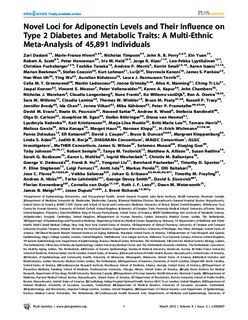Novel loci for adiponectin levels and their influence on type 2 diabetes and metabolic traits: a multi-ethnic meta-analysis of 45,891 individuals
| dc.contributor.author | Dastani, Z | |
| dc.contributor.author | Hivert, Marie-France | |
| dc.contributor.author | Timpson, Nicholas J. | |
| dc.contributor.author | Perry, John R.B. | |
| dc.contributor.author | Yuan, Xin | |
| dc.contributor.author | Scott, Robert A. | |
| dc.contributor.author | Henneman, Peter | |
| dc.contributor.author | Heid, Iris M. | |
| dc.contributor.author | Kizer, Jorge | |
| dc.contributor.author | Lyytikäinen, Leo-Pekka | |
| dc.contributor.author | Hveem, Kristian | |
| dc.contributor.author | Platou, Carl Geoffrey Parrinder | |
| dc.date.accessioned | 2019-10-14T11:09:24Z | |
| dc.date.available | 2019-10-14T11:09:24Z | |
| dc.date.created | 2013-01-20T21:17:07Z | |
| dc.date.issued | 2012 | |
| dc.identifier.citation | PLoS Genetics. 2012, 8 (3), 1-23. | nb_NO |
| dc.identifier.issn | 1553-7390 | |
| dc.identifier.uri | http://hdl.handle.net/11250/2621945 | |
| dc.description.abstract | Circulating levels of adiponectin, a hormone produced predominantly by adipocytes, are highly heritable and are inversely associated with type 2 diabetes mellitus (T2D) and other metabolic traits. We conducted a meta-analysis of genome-wide association studies in 39,883 individuals of European ancestry to identify genes associated with metabolic disease. We identified 8 novel loci associated with adiponectin levels and confirmed 2 previously reported loci (P = 4.5×10−8–1.2×10−43). Using a novel method to combine data across ethnicities (N = 4,232 African Americans, N = 1,776 Asians, and N = 29,347 Europeans), we identified two additional novel loci. Expression analyses of 436 human adipocyte samples revealed that mRNA levels of 18 genes at candidate regions were associated with adiponectin concentrations after accounting for multiple testing (p<3×10−4). We next developed a multi-SNP genotypic risk score to test the association of adiponectin decreasing risk alleles on metabolic traits and diseases using consortia-level meta-analytic data. This risk score was associated with increased risk of T2D (p = 4.3×10−3, n = 22,044), increased triglycerides (p = 2.6×10−14, n = 93,440), increased waist-to-hip ratio (p = 1.8×10−5, n = 77,167), increased glucose two hours post oral glucose tolerance testing (p = 4.4×10−3, n = 15,234), increased fasting insulin (p = 0.015, n = 48,238), but with lower in HDL-cholesterol concentrations (p = 4.5×10−13, n = 96,748) and decreased BMI (p = 1.4×10−4, n = 121,335). These findings identify novel genetic determinants of adiponectin levels, which, taken together, influence risk of T2D and markers of insulin resistance. | nb_NO |
| dc.language.iso | eng | nb_NO |
| dc.publisher | Public Library of Science | nb_NO |
| dc.rights | Navngivelse 4.0 Internasjonal | * |
| dc.rights.uri | http://creativecommons.org/licenses/by/4.0/deed.no | * |
| dc.title | Novel loci for adiponectin levels and their influence on type 2 diabetes and metabolic traits: a multi-ethnic meta-analysis of 45,891 individuals | nb_NO |
| dc.type | Journal article | nb_NO |
| dc.type | Peer reviewed | nb_NO |
| dc.description.version | publishedVersion | nb_NO |
| dc.source.pagenumber | 1-23 | nb_NO |
| dc.source.volume | 8 | nb_NO |
| dc.source.journal | PLoS Genetics | nb_NO |
| dc.source.issue | 3 | nb_NO |
| dc.identifier.doi | 10.1371/journal.pgen.1002607 | |
| dc.identifier.cristin | 993613 | |
| dc.description.localcode | 2012 Dastani et al. This is an open-access article distributed under the terms of the Creative Commons Attribution License, which permits unrestricted use, distribution, and reproduction in any medium, provided the original author and source are credited. | nb_NO |
| cristin.unitcode | 194,65,20,15 | |
| cristin.unitname | Helseundersøkelsen i Nord-Trøndelag | |
| cristin.ispublished | true | |
| cristin.fulltext | original | |
| cristin.qualitycode | 2 |

